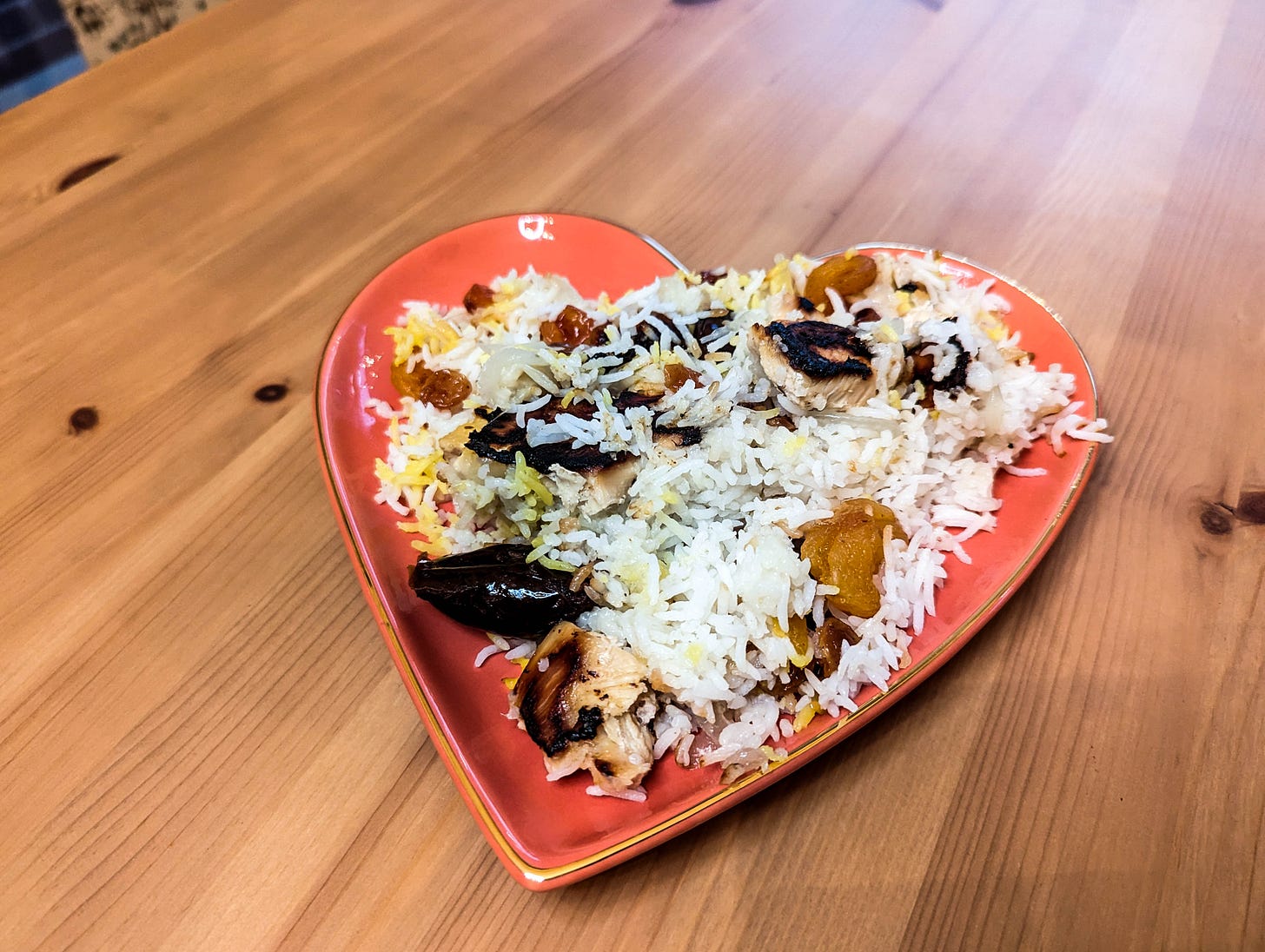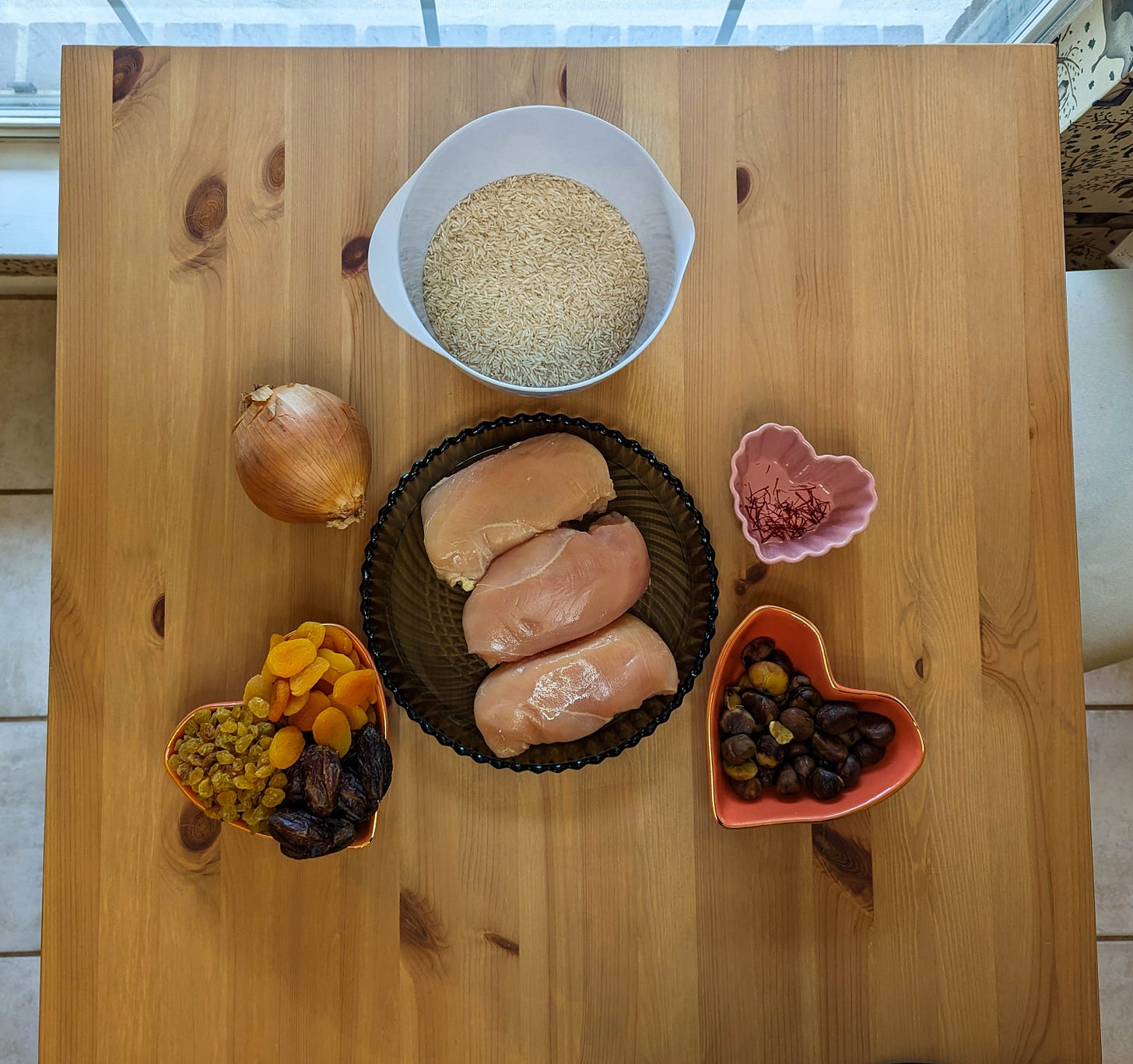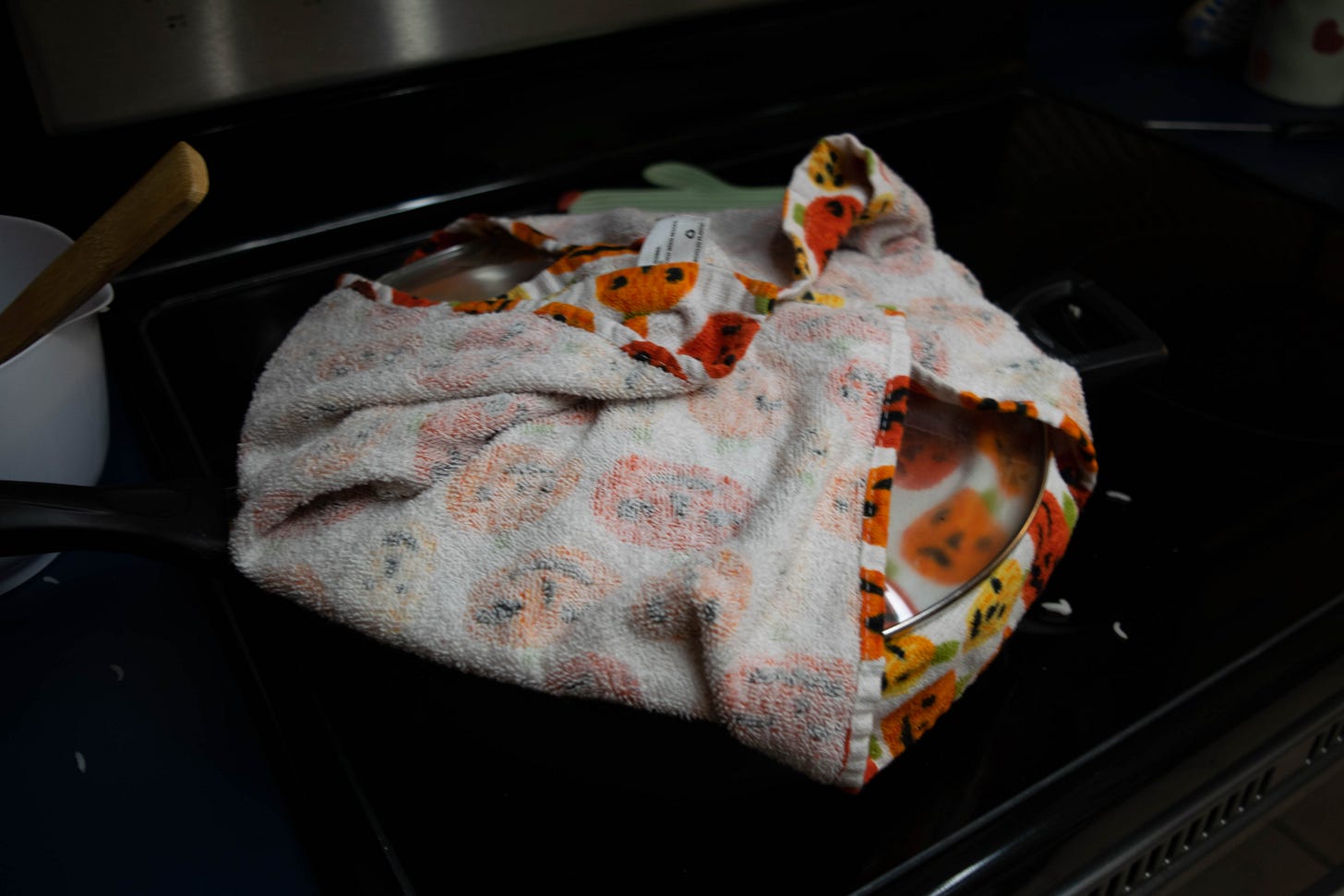Cooking for the Azerbaijan Grand Prix: Plov
Welcome to Grand Prix Gastronomy! This week, I’m cooking plov, Azerbaijan's national rice dish.
This project is pretty simple. As a complement to each race weekend, I’ll be cooking the national dish of that race’s host country and sharing information about the process and that dish’s history along the way in an effort to grow more deeply immersed in the local culture from my own home.
What Is Plov?
I don't think any other recipe on my list had a more uninviting name than this one. Plov is a rice dish from Azerbaijan that’s unique in its inclusion of tons of dried fruits and considered the national meal of the country. It's a fiercely local meal, with the ingredients differing depending on the various regions of the country, but at its most basic you can expect to find spiced rice layered with chestnuts, dried fruit, and meat (I opted for chicken).
There are a lot of different ways to prepare and serve plov, but my recipe calls for the one-pot style, where you cook everything in the same pan and add it all back in at different times.
This Week's Recipe
I wasn’t really sure where to begin with plov, so I decided to play it safe and pick a recipe from the Explore Azerbaijan website under the assumption that an official website would have an authentic recipe representative of the country. I ended up making parcha-dosheme plov, opting for a recipe with chicken, since I was a little unsure how I felt about the other components of the dish.
I'll be horrifyingly sincere for a moment: I struggle with rice dishes. I spent a few years battling an eating disorder, and while I've mostly pushed through some of the nastiest parts of my diet, there are still some things I struggle with — like eating a meal that is mostly composed of rice, which, for a long time, was A Bad Carb To Be Eaten In Very Small Quantities. I felt okay with Bahrain's machboos because it featured a lot of components I was familiar with. Plov — with its new cooking technique and its addition of foods I've never cooked with, like chestnuts and dried fruits — was more intimidating. So, I stuck with chicken — a food I'm very comfortable with — and also doubled the amount of meat in the recipe. There might be a version of plov that better suits Baku, but this was the recipe that was easiest for my brain to manage.
Now, with that all sorted out, let's get on to the fun stuff!
Cooking Plov
Of all the recipes I've made so far, this was the simplest in terms of both preparation and assembly. Everything can essentially be cooked in the same pan if you're willing to wipe it out a few times, and the only chopping required at the start was chicken and onions. Otherwise, you just pop a whole bunch of dried fruits into a pan with butter, stir fry them, remove them, partially cook the rice, remove it, then layer up the chicken, onions, rice, and dried fruits. Easy!
For my recipe, I actually doubled the amount of chicken called for in the recipe, mostly because I am a Protein Fiend, and I felt like that extra pound of meat did a lot for the dish. I could have done to use a pan with a thicker bottom than the T-fal pan I used; because you're layering everything, you don't stir the plov once you assemble it and pop on the lid to steam. As a result, my chicken did get a little too crispy on the bottom — it was still edible, but if I'd left it on the heat much longer, it would have become a problem.
Anyway, back to prep. You're going to halve the onion and thinly slice it to get tiny half-moons, then you want to cut the chicken into whatever size cubes you prefer. And that's it, prep done!
Unless you count sautéeing your dried fruit as prep — but that, too, is pretty easy. Melt some butter and add in your chestnuts and all the dried fruits with the exception of the golden raisins and stir fry it all up. (I also should note that the recipe I use calls for dried sour plums. I didn't end up buying those because I forgot! I replaced them with equal parts of the rest of the fruits.) When you're about two minutes from being done, add in the golden raisins; if you leave them in much longer, they'll burn, and some of mine did get a little blackened because I wasn't paying attention. Oops!
(At this point, I recommend you try some of the warm, sautéed fruit. The butter will have rehydrated them just a little bit, so they'll be nice and juicy. The tartness of the fruit is balanced out by the fatty, salty butter, and it is actually amazing.)
Remove those from the pan and, if it's large enough, wipe the pan out; you can fill it with salted water and then add in your rice (which you'll want to rinse and let soak before you cook it to remove the starch and make an ultra-fluffy rice). You want that water to be salty because the rice is going to be the main component of the dish, so you need to get the flavor in while you can. Follow the recipe instructions for cooking the rice; you still want it a little crunchy because you'll continue cooking it in a minute. Until now, strain the rice, discard the water, and heat up some oil in your pan again.
Now you'll add the chicken. I had exactly enough to create a pretty solid single layer on the bottom of the pan, which is what you want. Then, layer the onions on top of it. Add half the rice next, flatten it, then arrange the dried fruits and top everything back up with the rest of the rice. Before you finish up this part, you'll also drizzle melted butter on the rice. I doubled the amount of butter the recipe called for in my preparation, and I probably could have doubled it again (I like butter).
Here's one of the more interesting parts of the whole cooking process. You're going to drape a (clean) dishtowel over the plov before you cover the pot with its lid. Gather the edges of the cloth onto the top of the lid so they don't burn, and then let the plov sit for a while. That towel helps steam the rice, which is what's going to complete its cooking process.
Partway through cooking, you'll remove the lid and drizzle saffron water over the top of the rice. The recipe I chose says to “dissolve” the saffron in the water, but you can't dissolve saffron. Let it steep like tea in some hot water, then remove the saffron strands before you drizzle. Cover it back up to steam for a little while longer, and voila. That's plov, baby!
So, What's the Verdict?
I wasn't actually expecting all that much from plov… but I ended up being kind of obsessed, to the point that I'm really itching to cook it again. The ingredients are deceptively simple, and after the ultra-spiced machboos, I was wondering how a comparatively "plain” (read: not highly spiced) dish would stack up. But it was delicious.
I think the biggest thing worth noting is the importance of soaking the rice in highly salted water, which imparted it with flavor even before I cooked it. Then, the butter and saffron water created so much unexpected depth. Paired with the sweet, salty bites of the dried fruit prepared in butter and the crispy crust that formed on the chicken, the rice was perfect. I was legitimately sad when I finished off the last of my leftovers.
When I make this again, though, I will admittedly cut the rice down and add even more meat. I still have a hard time convincing myself that the bulk of my meal can just be Basmati rice, and I do appreciate the extra protein, since I've been trying my hand at weightlifting. These aren't criticisms of the recipe or cuisine, though; they're just personal preferences based on my own set of internalized values. All I know is that I’m going to be adding dried fruits to more savory meals, and that I'm going to find an excuse to cook with chestnuts, which turned into delightfully creamy little bites of flavor.
Let's Chat! A Note on Sportswashing
Formula 1 is a geopolitical powerhouse of a form of entertainment, which means we're going to come head to head with a lot of deeply uncomfortable and complex issues regarding human rights. For my editions on Bahrain, Saudi Arabia, and now Azerbaijan, I've had people voice their concerns that Grand Prix Gastronomy is overlooking human rights abuses and merely celebrating F1 — including as it pertains to some of the shittier elements of “working with a government to paint a pretty picture of a country that has caused pain, strife, and worse among its people.”
First off, I'd love to direct you to a podcast I wrote and hosted on this exact issue. Its focus is on Saudi Arabia, but its lessons engage with the complexity of human rights abuses as we see them around the world — including in America and the UK.
The absolute last thing I want to do is turn my eyes away from systemic inequality. I don't want to do that in any facet of my life, and definitely not with this project.
Instead, my goal for GPG is to actually engage meaningfully with the host country through the medium of food. As a Westerner, I know that my biases are really gnarly. There's a tendency for us to look at places like Eurasia, Africa, or the Middle East and say, “Those countries are wholly bad, and we should avoid engaging with them at all.”
Doing that, though, closes our worldview in drastic ways. We lose out on developing the sociopolitical understanding that can help us see how, say, a government's reliance on forced disappearances, indefinite jailing, and more. Looking deeper into a country and its development stemming back millennia will only help us to find effective ways to combat the insidious mindsets that have harmed a set of people.
For me and many others, food has served as a gateway to developing an understanding of a place. You can learn a lot about a country by researching its cuisine and cooking its national dish. Its ingredients teach you about the foods native to that area, which in turn provides us with a look into the geological conditions that enable that ingredient to grow, the trade routes that must have been in place to facilitate the acquisition of an ingredient, and the forms of energy that people most valued. The process of cooking teaches you about cultural tradition and a place's ways of making meaning — what religious or cultural systems influenced the selection, specific preparation, or serving rituals were in place.
Will GPG provide you with a clear lens and wholehearted understanding of a culture? No. But this isn't the time or place for that. At the same time, however, I don't believe anyone can understand the multifaceted features of a country by engaging only with its human rights abuses, or by discounting all of a place's cultural complexities.
What I'm hoping to do with this project is remind people that these countries are more than just the pain they've caused, because strict demonization will never enable us to find a solution to human rights abuses that both provide meaningful change while also paying respect to a non-Western culture. I'm hoping to remind people that there are people in Saudi Arabia, Bahrain, Azerbaijan, Qatar (and yes, even the U.S.) that disagree just as strongly with the abuses of their country but who still live there for one reason or another. Those people deserve to see the best parts of their culture understood with the same desire to learn that we apply to Western nations. They deserve to know we care about developing empathy for the people who are impacted, that we'll protect their cultural integrity as we challenge embedded political wrongs.
As a journalist, my nuanced grapplings with the sociopolitics of controversial countries have a home on places like Jalopnik. GPG is instead the place where I find a new lens through which to look at a country, the place where I take the time to learn about embedded traditions, cultural mores, and history, so that I'm able to approach future activism with deeper respect. I hope you'll continue to join me on the journey.
If you want to stay tuned…
Here are all the relevant links in one place, if you want to subscribe:
All Grand Prix Gastronomy-related content will be free — but if you want to drop me a donation on PayPal, that’s always welcome.













Just found your site and it's awesome. I've been cooking a recipe from the host country of F1 Grand Prix races for almost 30 years now and it's great to see someone else doing it. I'm trying your Plov recipe for this weekend.
This recipe is awesome, your conflicted feelings on enjoying it are legitimate, and this entire GPG project is inspired. I can't wait to see what three dishes you choose for the American races. As a Midwesterner, I'll probably be disappointed if they don't involve Busch Light or some sort of casserole.